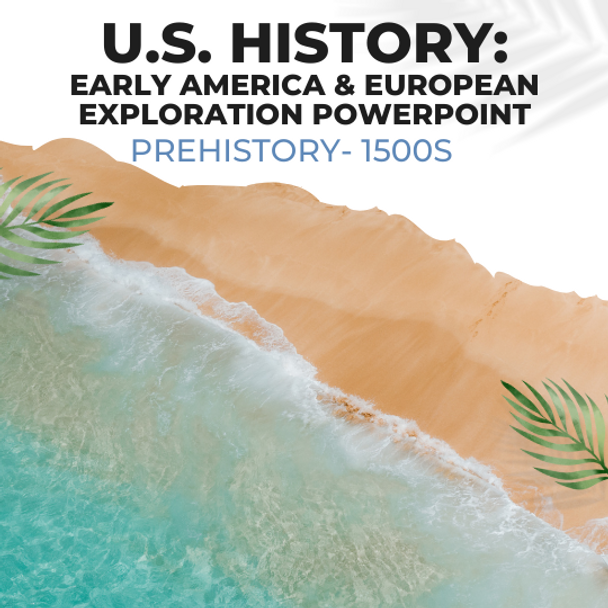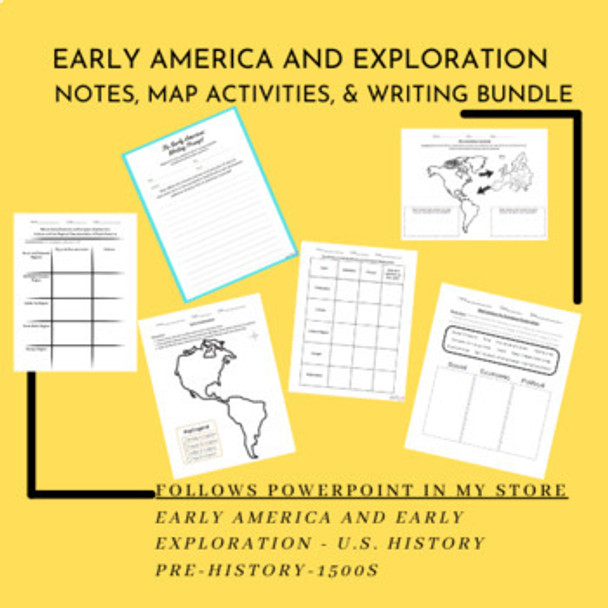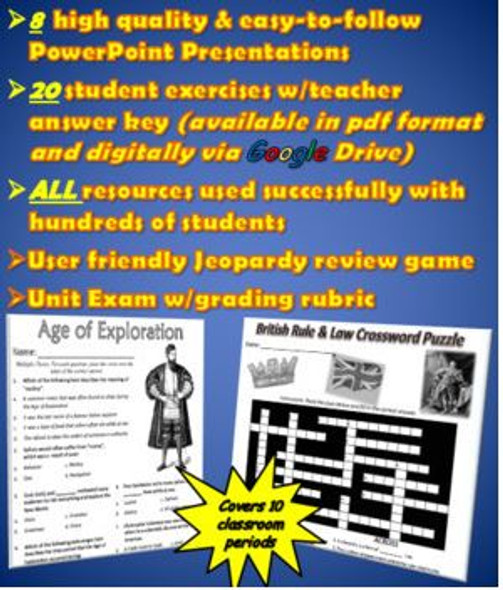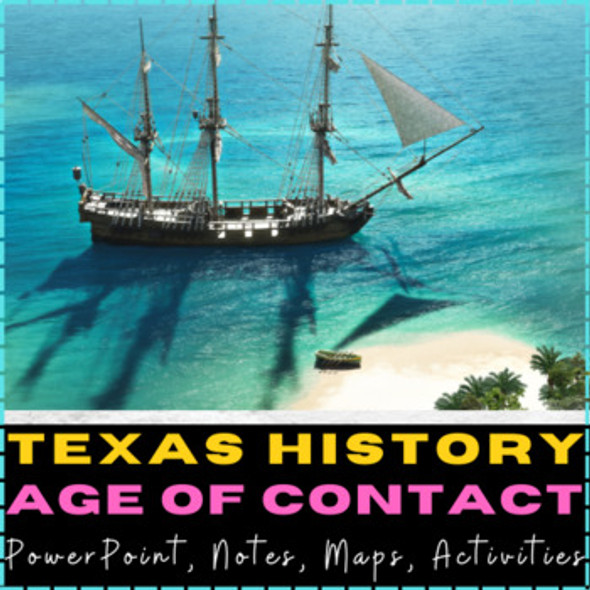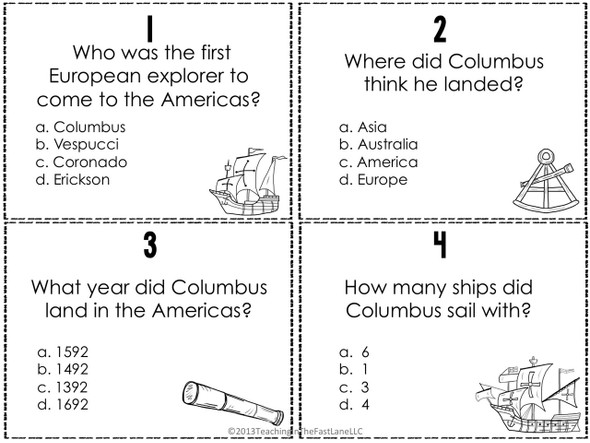Description
14 Products in 1 Bundle!
Everything you need for teaching European exploration and the 13 colonies in North America for your U.S. History class.
________________________________________________________________
ACE THE EXAM...This bundle includes everything you need to ace the test...
- Review PowerPoint with a review packet that follows the PPT (PPT works as key)
- A map quiz w/key
- Information quiz w/key
- Study guide w/key
- Unit exam w/key
THIS REVIEW BUNDLE COVERS:
- Review of exploration and the Columbian Exchange
- Spanish colonization
- French colonization
- Dutch colonization
- Roanoke
- Jamestown
- New England Colonies (settlement, economy, geography, climate, modification of environment, government, religion, daily life, & society)
- House of Burgesses
- The Mayflower Compact
- Thomas Hooker
- Fundamental Order of Connecticut
- Middle Colonies (settlement, economy, geography, climate, modification of environment, government, religion, daily life, & society)
- William Penn and the Quakers
- Southern Colonies (settlement, economy, geography, climate, modification of environment, government, religion, daily life, & society)
- Transatlantic slave trade & the middle passage
- Mercantilism
- Growth of representative government in the colonies
- The Great Awakening & Jonathan Edwards
- Enlightenment: John Locke, & Charles de Montesquieu
TEKS & LEARNING OBJECTIVES FOR THE ACE THE EXAM BUNDLE:
- 8.3(A) explain the reasons for the growth of representative government and institutions during the colonial period
- 8.7(C) analyze the impact of slavery on different sections of the United States
- 8.10(B)^ compare places and regions of the United States in terms of physical and human characteristics
- 8.10(C)^ analyze the effects of physical and human geographic factors such as weather, landforms, waterways, transportation, and communication on major historical events in the United States
- 8.11(A)^ analyze how physical characteristics of the environment influenced population distribution, settlement patterns, and economic activities in the United States
- 8.12(B) explain reasons for the development of the plantation system, the transatlantic slave trade, and the spread of slavery
- 8.12(C)^ analyze the causes and effects of economic differences among different regions of the United States at selected times
- 8.15(D)^ analyze … the principles of limited government, republicanism, … popular sovereignty, …
- 8.23(A) identify racial, ethnic, and religious groups that settled in the United States and explain their reasons for immigration
- 8.1(B)^ explain the significance of the following dates: 1607, founding of Jamestown; 1620, arrival of the Pilgrims and signing of the Mayflower Compact; …
- 8.2(B) compare political, economic, religious, and social reasons for the establishment of the 13 English colonies
- 8.3(B) analyze the importance of the Mayflower Compact, the Fundamental Orders of Connecticut, and the Virginia House of Burgesses to the growth of representative government
- 8.3(C) describe how religion and virtue contributed to the growth of representative government in the American colonies
- 8.7(B) compare the effects of political, economic, and social factors on slaves and free blacks
- 8.10(A)^ locate places and regions directly related to major eras and turning points in the United States during the 17th, 18th, … centuries
- 8.11(B)^ describe the positive and negative consequences of human modification of the physical environment of the United States
- 8.12(A)^ identify economic differences among different regions of the United States
- 8.15(E) explain the role of significant individuals such as Thomas Hooker, Charles de Montesquieu, and John Locke in the development of self‐government in colonial America
- 8.23(D)^ analyze the contributions of people of various racial, ethnic, and religious groups to our national identity
- 8.25(A) trace the development of religious freedom in the United States
**Great for STAAR review!
_________________________________________________________________
U.S. History: Colonial America PowerPoint-over 200 slides & 88 Pages of Resources:
THIS EDITABLE POWERPOINT (224 SLIDES) COVERS:
- Vocabulary terms
- Review of exploration and the Columbian Exchange
- Protest Reformation
- Spanish colonization
- French colonization
- Dutch colonization
- Roanoke
- Jamestown
- New England Colonies (settlement, economy, geography, climate, modification of environment, government, religion, daily life, & society)
- Magna Carta
- House of Burgesses
- Enslaved Africans in the colonies
- Bacon's Rebellion
- Pilgrims & Plymouth
- The Mayflower Compact
- Puritans
- Thomas Hooker
- Fundamental Order of Connecticut
- Anne Hutchinson
- King Phillip's War
- Middle Colonies (settlement, economy, geography, climate, modification of environment, government, religion, daily life, & society)
- William Penn and the Quakers
- Compare contrast Puritans and Quakers
- Southern Colonies (settlement, economy, geography, climate, modification of environment, government, religion, daily life, & society)
- Lord Baltimore
- Act of Toleration
- Slavery & plantations
- Transatlantic slave trade & the middle passage
- Mercantilism
- Navigation Acts
- The Glorious Revolution & the English Bill of Rights
- Growth of representative government in the colonies
- Social classes
- Art, literature, and music in the colonies
- Education in the colonies
- The Great Awakening & Jonathan Edwards
- Enlightenment: John Locke, Benjamin Franklin, Charles de Montesquieu, and more
THIS PACKAGE OF RESOURCES INCLUDES:
- 3 Vocabulary charts
- 14 Pages of Cornell-style notes - follows the PowerPoint
- 24 Writing prompts
- 8 Map activities
- 6 Venn diagrams
- Movie guide for National Geographic's Nightmare in Jamestown-key included
- 2 Webquests-keys included
- 1 Project (comparing colonies)
- 1 Map quiz
- And so much more!
TEKS & LEARNING OBJECTIVES FOR THE POWERPOINT AND RESOURCES:
- 8.3(A) explain the reasons for the growth of representative government and institutions during the colonial period
- 8.7(C) analyze the impact of slavery on different sections of the United States
- 8.10(B)^ compare places and regions of the United States in terms of physical and human characteristics
- 8.10(C)^ analyze the effects of physical and human geographic factors such as weather, landforms, waterways, transportation, and communication on major historical events in the United States
- 8.11(A)^ analyze how physical characteristics of the environment influenced population distribution, settlement patterns, and economic activities in the United States
- 8.12(B) explain reasons for the development of the plantation system, the transatlantic slave trade, and the spread of slavery
- 8.12(C)^ analyze the causes and effects of economic differences among different regions of the United States at selected times
- 8.15(D)^ analyze … the principles of limited government, republicanism, … popular sovereignty, …
- 8.23(A) identify racial, ethnic, and religious groups that settled in the United States and explain their reasons for immigration
- 8.1(B)^ explain the significance of the following dates: 1607, founding of Jamestown; 1620, arrival of the Pilgrims and signing of the Mayflower Compact; …
- 8.2(B) compare political, economic, religious, and social reasons for the establishment of the 13 English colonies
- 8.3(B) analyze the importance of the Mayflower Compact, the Fundamental Orders of Connecticut, and the Virginia House of Burgesses to the growth of representative government
- 8.3(C) describe how religion and virtue contributed to the growth of representative government in the American colonies
- 8.7(B) compare the effects of political, economic, and social factors on slaves and free blacks
- 8.10(A)^ locate places and regions directly related to major eras and turning points in the United States during the 17th, 18th, … centuries
- 8.11(B)^ describe the positive and negative consequences of human modification of the physical environment of the United States
- 8.12(A)^ identify economic differences among different regions of the United States
- 8.15(E) explain the role of significant individuals such as Thomas Hooker, Charles de Montesquieu, and John Locke in the development of self‐government in colonial America
- 8.23(D)^ analyze the contributions of people of various racial, ethnic, and religious groups to our national identity
- 8.25(A) trace the development of religious freedom in the United States
PLEASE NOTE:
- PowerPoints need to have their content enabled before presenting
- Videos are included in the PowerPoint
- The Serif Hand Black and The Hand Bold are the primary fonts used in this presentation. You may need to adjust the font/size if you do not have a version of PowerPoint that includes these fonts.
- Discussion questions and cooperative learning activities (with instructions and timers) to check for understanding are included in the PowerPoint
_________________________________________________________________
U.S. History: Exploration and the 13 Colonies - Anchor Charts:
Utilize this 18 page set for ready to go anchor charts/study guides, or as notes for your students to complete as you move through this era (KEY INCLUDED).
THIS SET COVERS:
- Exploration of the Americas
- Reasons for Colonization of the Americas
- Religious Group Immigration from Europe to Colonial America
- Growth of Representative Government in the 13 Colonies
- Early Representative Government in the 13 Colonies
- Religious Impact on Representative Government in Colonial America
- Colonial Regions
- Colonial Economies & Mercantilism
- Plantations & Slavery in Colonial America
_________________________________________________________________
PowerPoint: Early America and Early Exploration - U.S. History Pre-History-1500s:
Utilize this PowerPoint (61 slides & editable) to set the stage for teaching about early exploration and colonization of the "New World" for your U.S. History class.
THIS POWERPOINT COVERS:
- Vocabulary terms
- Beringia
- How early Americans modified and adapted to their environment
- Overviews of Olmec, Aztec, Mayan, and Inca civilizations
- Physical and early cultural regions of North America
- The Middle Ages
- Feudalism
- The Crusades
- Trade
- Silk Road
- Europe's Renaissance
- Vikings in the Americas
- Columbus
- Motivations for exploration
- Columbian Exchange
TEKS/LEARNING OBJECTIVES:
- 8.2.A identify reasons for European exploration and colonization of North America
- 8.1.B apply absolute and relative chronology through the sequencing of significant individuals, events, and time periods
- 8.10.B compare places and regions of the United States in terms of physical and human characteristics
- 8.10.C analyze the effects of physical and human geographic factors on major historical and contemporary events in the United States
- 8.11.B describe the positive and negative consequences of human modification of the physical environment of the United States
PLEASE NOTE:
- PowerPoints need to have their content enabled before presenting
- Videos are included in the PowerPoint
- Franklin Gothic Book and Bookman Old Style are the primary fonts used in this presentation - you may need to adjust the font/size if you do not have a version of PowerPoint that includes these fonts
- Discussion questions are included in the PowerPoint
- Questions to check for understanding are included in the PowerPoint
_____________________________________________________________
Early America & Exploration Resources: Notes, maps, writing, and more!
This 25 page bundle of resources follows the PowerPoint in my store titled "Early America and Early Exploration - U.S. History Pre-History-1500s".
THIS BUNDLE INCLUDES:
- 2 pages of unit vocabulary
- 7 pages of Cornell style notes that follow the PowerPoint
- 6 writing prompts on lined pages
- 10 pages of maps and questions that follow the lessons in the PowerPoint
TEKS/LEARNING OBJECTIVES:
- 8.2.A identify reasons for European exploration and colonization of North America
- 8.1.B apply absolute and relative chronology through the sequencing of significant individuals, events, and time periods
- 8.10.B compare places and regions of the United States in terms of physical and human characteristics
- 8.10.C analyze the effects of physical and human geographic factors on major historical and contemporary events in the United States
- 8.11.B describe the positive and negative consequences of human modification of the physical environment of the United States
________________________________________________________________
JEOPARDY REVIEW GAME:
Gamify your European exploration and 13 colonies with this editable Jeopardy-esque review game!
*Students do not have to answer with a question in this version as I frequently have students quite concerned with how to word their response, when I want them focused on our unit's material.
Content covered in this PowerPoint:
- Columbus
- Motivations for exploration
- Columbian Exchange
- Jamestown
- House of Burgesses
- Pilgrims arriving in Plymouth
- Mayflower Compact
- Fundamental Orders of Connecticut
- Thomas Hooker
- Montesquieu
- William Penn
- John Locke
- George Oglethorpe
- Mercantilism
- Transatlantic Slave Trade
- New England's economy, geography, colonies, and more!
- Middle Colonies' economy, geography, colonies, and more!
- Southern Colonies' economy, geography, colonies, and more!
Learning Objectives/TEKS:
- 8.3(A) explain the reasons for the growth of representative government and institutions during the colonial period
- 8.7(C) analyze the impact of slavery on different sections of the United States
- 8.10(B)^ compare places and regions of the United States in terms of physical and human characteristics
- 8.10(C)^ analyze the effects of physical and human geographic factors such as weather, landforms, waterways, transportation, and communication on major historical events in the United States
- 8.11(A)^ analyze how physical characteristics of the environment influenced population distribution, settlement patterns, and economic activities in the United States
- 8.12(B) explain reasons for the development of the plantation system, the transatlantic slave trade, and the spread of slavery
- 8.12(C)^ analyze the causes and effects of economic differences among different regions of the United States at selected times
- 8.15(D)^ analyze … the principles of limited government, republicanism, … popular sovereignty, …
- 8.23(A) identify racial, ethnic, and religious groups that settled in the United States and explain their reasons for immigration
- 8.1(B)^ explain the significance of the following dates: 1607, founding of Jamestown; 1620, arrival of the Pilgrims and signing of the Mayflower Compact; …
- 8.2(B) compare political, economic, religious, and social reasons for the establishment of the 13 English colonies
- 8.3(B) analyze the importance of the Mayflower Compact, the Fundamental Orders of Connecticut, and the Virginia House of Burgesses to the growth of representative government
- 8.3(C) describe how religion and virtue contributed to the growth of representative government in the American colonies
- 8.7(B) compare the effects of political, economic, and social factors on slaves and free blacks
- 8.10(A)^ locate places and regions directly related to major eras and turning points in the United States during the 17th, 18th, … centuries
- 8.11(B)^ describe the positive and negative consequences of human modification of the physical environment of the United States
- 8.12(A)^ identify economic differences among different regions of the United States
- 8.15(E) explain the role of significant individuals such as Thomas Hooker, Charles de Montesquieu, and John Locke in the development of self‐government in colonial America
- 8.23(D)^ analyze the contributions of people of various racial, ethnic, and religious groups to our national identity
- 8.25(A) trace the development of religious freedom in the United States
**Great for STAAR Review!
_________________________________________________________________
WORD WALL:
Utilize this word wall set (20 terms) to display to give your students visual cues and reminders of some of the important terms from this unit. Definitions are not included in the word wall set.
Vocabulary terms include: conquistador, plantation, Mayflower Compact, Quakers, Cash crops, Protestant Reformation, mercantilism, indentured servants, and more!
----------------------------------------------------------------------------------------------------------------------
Hexagonal Thinking: Exploration & Colonization
Hexagonal Thinking - U.S. History - the 13 Colonies: 84 hexagons and important terms from the era of the 13 colonies.
Note to Teacher:
Hexagonal thinking is a method of learning for considering the connections between ideas and finding the nuances in those connections. Each student, group, or class can make unique shapes, and connections using this hexagon cards. This is a fun and creative way to review for a test and to get your students to work together as a team.
DIRECTIONS:
Before class, cut out all hexagons. (I also recommend printing them on cardstock and laminating the sheets, before cutting them out.) You can do this activity in small groups, or make it an activity for the entire class if you have a large floor space to utilize. Pass out the Hexagons to students, except for one piece that you will keep. Put down your piece first and have your students build off of it. Each hexagon can connect to up to six others. Students should Arrange and rearrange until they feel they have the strongest hexagon web in place that they can and all hexagon cards have been used. Students cannot place a hexagon down if they cannot explain the connection to each of the surrounding hexagons that it will touch.
HistoTeam- Trust the Team! CLICK HERE FOR MORE HISTORY RESOURCES BY THE HISTOTEAM


